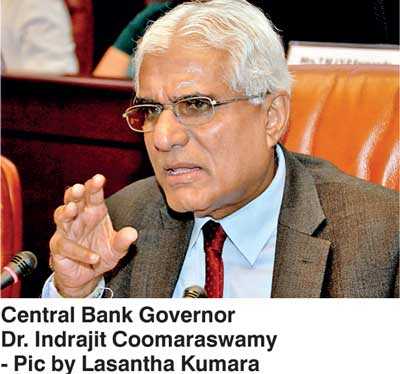Saturday Apr 19, 2025
Saturday Apr 19, 2025
Monday, 9 July 2018 00:27 - - {{hitsCtrl.values.hits}}
By Uditha Jayasinghe
Moderate first quarter performance has prompted the Central Bank to revise down the growth target for 2018 to 4%-4.5% from an initial forecast of 4.5%-5% with its Chief Dr. Indrajit Coomaraswamy cautioning against reducing interest rates to spur growth as it could lead to a balance of payments crisis.

Sri Lanka grew 3.2% in the first quarter of 2018, slowing marginally from the 3.5% expansion seen in the fourth quarter of 2017 and the 3.3% growth in the first quarter of last year. The quarter saw a recovery of agricultural activities, which expanded 4.8% compared with the first quarter of 2017 but the industry and services sectors remained subdued.
Earlier this month the World Bank projected Sri Lanka to grow at 4.3%, while the International Monetary Fund (IMF) had predicted 4%.
Addressing reporters at the monetary policy announcement last Friday, Dr. Coomaraswamy noted that initial projections for the economy to grow close to 5% were being revised by the Central Bank with new targets likely to be announced in August.
“The Central Bank is in the process of revising growth targets for 2018. I think 5% growth would be very ambitious indeed. We have had 3.2% growth for the first quarter but it will pick up in the next half but we are revising targets. By the time we meet next time we will have a revised target for you. It is unlikely to be below 4% but likely to be between 4% and 4.5%,” he said.
The Central Bank decided to keep policy rates steady last week, balancing off low inflation and an output gap with external pressures including an appreciating dollar and the US Federal Reserve increasing interest rates. The Government is likely to meet its 30 June fiscal targets but the Governor acknowledged a close eye would be kept on possible fiscal slippage. Doubling of vehicle imports, which contributed to an expanding trade deficit in the last couple of months along with gold, could be tackled through macro prudential measures, the Governor noted.
The Central Bank also expects nominal and real interest rates would gradually adjust downwards in line with the neutral policy stance announced earlier this year, which signalled the end of the tightening cycle. Broad money growth decelerated to 15% in May 2018 from 16.8% in April 2018, with the deceleration in domestic credit expansion and net foreign assets. Private sector credit growth decelerated to 15.1% (y-o-y) in May 2018 from 15.3% in April 2018. Private sector credit is expected to grow by around 13%-14% by end 2018 which would be in excess of Rs. 650 billion. Reserves were at $ 9.2 billion at the end of June.
“Often when growth is low and elections approach there is a great deal of pressure to reduce interest rates as a way of boosting growth and economic activity. But there are a number of reasons why this would be singularly unwise. We have said all along we will have a data driven monetary policy and if you look at the data it does not recommend a loosening of monetary policy. Nominal GDP is growing at about 8%, yet credit growth is 15%, so there is plenty of money. Real credit growth is 10%, now this economy has grown at much faster rates with much higher interest rates. For instance, when inflation was 10% there were interest rates well above what they are now and yet there was higher growth. Not only that, if you look at the first half of 2016, there was credit growth of 28% but growth was only 4% or less.
“Our research department has done some very interesting analytical research, which shows the relationship between interest rates and growth or the link between credit growth and economic expansion has been weakening. The reason for low growth is not the cost of funds. There are lots of other things that affect the confidence in the country’s investment sentiments, expectations and structural problems, all these need to be addressed. Just reducing interest rates and pumping money into the economy, particularly at a time when the trade deficit and the current account are deteriorating is not a good course of action.”
The Governor insisted the best recipe to boost growth was through effective market reform, improved investment climate, better investment promotion, trade facilitation and using Sri Lanka’s trade policy to take advantage of the country’s location.
“These are the things that we need to do to drive growth and just creating an artificial boom by reducing interest rates, would create a boom in terms of consumption growth and cause a balance of payments problem, but it doesn’t seem likely that it will boost growth, if you look at the data.”